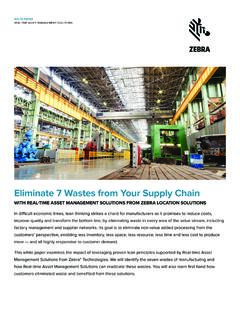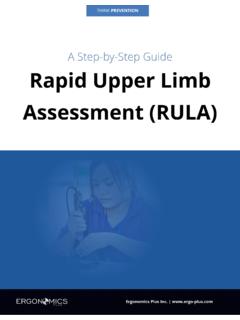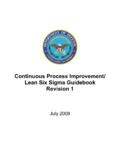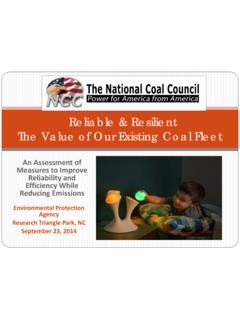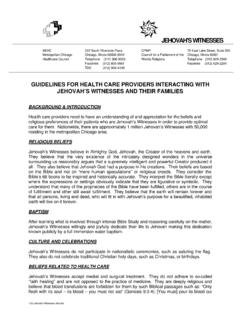Transcription of Reducing Food Waste Packaging - epa.gov
1 Reducing Wasted Food & Packaging : A Guide for Food Services and RestaurantsUnited States Environmental Protection AgencyThe information contained on these pages is intended to inform the public and does not establish or affect legal rights or obligations. This applies to all pages in the Reducing Wasted Food & Packaging : A Guide for Food Services and Restaurants. Links to non-EPA sites do not imply any official EPA endorsement of, or responsibility for, the opinions, ideas, data or products presented at those locations, or guarantee the validity of the information provided. Reference to any specific commercial products, process or service by trade name, trademark, manufacturer, or otherwise, does not necessarily constitute or imply its endorsement, recommendation, or favoring by the United States Government and shall not be used for advertising or product endorsement.
2 1 Why Reduce Wasted Food and Packaging ? ..1 Ways to Reduce Wasted Food and Packaging ..3 Food and Packaging Waste Reduction: Strategy Checklist ..4 Step One To Reducing Your Waste : Tracking and Assessing ..5 How Does EPA s Free Tool on Food and Packaging Waste Prevention Work? ..5 Steps to Using the Tool ..6 What is Source Reduction ..7 Wasted Food Reduction Strategies ..8 Source Reduction Strategies ..8 Case Studies ..10 Turn Source Reduction Strategies into Action! ..10 Feed Hungry People / Feed Animals ..11 Feed People, Not Landfills: Food Donation ..11 Feed Animals ..11 Case Studies ..12 Industrial Uses/Composting ..13 Industrial Uses ..13 Composting ..13 Anaerobic Digestion ..13 Case Studies ..14 Turn Waste Diversion Strategies into Action! ..15 Packaging Reduction Strategies ..16 Definition and Benefits of Packaging Reduction Strategies.
3 16 Strategies for Reducing Packaging ..16 Case Studies ..18 Turn Packaging Reduction Strategies into Action! ..18 Disposal ..19 Disposal Strategy ..19 Case Studies ..19 ContentsIntroductionWhy Reduce Wasted Food and Packaging ? Together, food and Packaging /containers account for almost 45% of the materials landfilled in the United States, and some of these discarded materials are food-related Packaging and containers . To reduce food reaching landfills, save money, and help communities, the U .S . Environmental Protection Agency started the Food Recovery Challenge . The Challenge is part of EPA s Sustainable Materials Management Program, which seeks to reduce the environmental impact of materials through their entire life cycle . Food service establishments generate a significant amount of wasted food and Packaging .
4 Between 4 and 10 percent of food purchased by food service operations in the U .S . is thrown out before reaching the plate .1 By Reducing the amount of food and Packaging discarded, they can significantly reduce their Waste stream and save you know 2010, over 33 million tons of food reached landfills in the U .S . equivalent to half a pound per person per day or enough food to fill the Rose Bowl Stadium every day.(Bloom. 2010. American Wasteland. www .americanwastelandbook .com) . [This link is for informational purposes only and does not imply endorsement by EPA .]This toolkit is designed to:Help food service establishments and commercial kitchens save money by Reducing wasted food and Packaging with suggested strategies, templates and case studies .1 Reducing Wasted Food and Packaging1 LeanPath, www .leanpath .com/resources/food- Waste -stats/.
5 [This link is for informational purposes only and does not imply endorsement by EPA .]Benefits of Reducing Wasted Food and Packaging Save money by Reducing over-purchasing and disposal costs Reduce environmental impacts Support efforts to eliminate hunger Reduce health and odor concerns with food disposal Support community Waste reduction efforts Increase tax benefits by donating food Reducing Wasted Food and Packaging 2 Reasons to Reduce Wasted FoodReason 1: Wasting food costs money Wasted food costs the commercial food service industry roughly $100 billion annually .2 Reducing wasted food and Packaging can save money by Reducing not only disposal costs but also over-purchasing, labor, and energy costs . Additionally, food service establishments can receive tax benefits from donating wholesome, edible food to food banks or food rescue organizations.
6 Reason 2: Wasting food is unnecessaryNot all food that reaches landfills is inedible. Wasted food can be divided into three categories: Avoidable: Food that can be easily prevented from going to Waste . Reasons for Waste include overpreparation, improper storage, or spoilage . Understanding the cause of this Waste is key to preventing it . Example: An entire tray of lasagna is left over every day at a avoidable: Food that may seem inedible but can be used or repurposed . Example: Beet tops can be cooked similarly to collard greens or spinach instead of discarded. Also, slightly stale bread can be used for croutons or bread crumbs. Unavoidable: Food that cannot be consumed by people and should be used for animal feed, compost, or anaerobic digestion . Example: Banana peels and peach pits. Reason 3: Wasting food has environmental impactsUnprecedented amounts of food are wasted in the United States.
7 In fact, more food reaches landfills and incinerators than any other single component of municipal solid Waste (MSW) . In 2010 alone, more than 34 million tons of wasted food were generated, with a meager three percent of this diverted from landfills and incinerators to composting (see Figure 1) . The damaging environmental effects of wasted food start with food rotting in landfills, which releases methane, a greenhouse gas (GHG) 21 times more potent than carbon dioxide . Thirteen percent of GHG emissions in the United States result from the growth, manufacturing, sale, transportation, and disposal of food . Additionally, large amounts of water and other resources are needed to grow and process food . More than a quarter of the total freshwater consumption per year in the United States is used to grow wasted food .3 Reducing discarded food avoids wasting the water, oil, and other natural resources that go into growing and delivering food.
8 4 Saving Food Saves MoneyFigure 1 . Percent of Total Waste Generation and Disposal of Municipal Solid Waste in the U .S . in 2010 Reduce Over-Purchasing Costs through Waste PreventionReduce Labor Costs & Increase Staff EfficiencyReduce Disposal CostsYARD TRIMMINGSFOODWOODTEXTILESRUBBER &LEATHEROTHERGLASSMETALSPLASTICSPAPER &PAPERBOARD9%4% 5%4% 7%8%16%17%21%9%2 Bloom. 2010. American Wasteland. www .americanwastelandbook .com . [This link is for informational purposes only and does not imply endorsement by EPA .]3 Hall et al . 2009 . The Progressive Increase of food Waste in America and its environmental impacts . 4 U .S . EPA www .epa .gov/oswer/docs/ghg_land_and_materials_m anagement .pdf3 Reducing Wasted Food and PackagingReasons to Reduce Wasted PackagingContainers and Packaging alone contribute over 23% of the material reaching landfills in the , and some of these discarded materials are food-related containers and Packaging .
9 Additionally, Packaging makes up a majority of the litter that ends up on our beaches and other waterways. This is a problem because fish, birds, and other aquatic wildlife are often harmed by ingesting plastic bags and other debris from Packaging . Waste in the ocean also causes navigation hazards for boats and results in losses to the shipping, fishing, and tourism industries. Ways to Reduce Wasted Food and Packaging The Food Recovery Hierarchy (see Figure 2) identifies the preferred options for handling excess food . Listed in order from the most preferred (source reduction) to the least preferred (landfilling/incineration), these activities help reduce the environmental impact of wasting food .Similar to the Food Recovery Hierarchy, the three main Packaging reduction strategies are: 1 . Source reduction or preventing Waste before it is created;2.
10 Reuse; and3 . Recycling/Composting . Did you know Packaging can conserve energy and reduce greenhouse gas emissions . You can calculate the greenhouse gas impacts of Reducing , recycling, and composting your organization s Packaging using EPA s Waste Reduction Model (WARM) at www .epa .gov/WARMF igure 2 . Food Recovery Hierarchy Reducing Wasted Food and Packaging 4 Reducing Wasted Food and Packaging : Strategy ChecklistAll Food Service Venues Conduct a wasted food and Packaging assessment using the EPA s Food and Packaging Waste Prevention Tool or another Waste tracking tool Adjust food purchasing policies to reduce excess food purchasing Use just-in-time purchasing software to reduce unnecessary purchasing Adjust menus to reduce frequently uneaten or wasted items Train staff to reduce prep Waste and improper cooking (for example, refine knife skills to have more efficient food preparation) Modify food preparation methods to minimize Waste (for example, heat soups or prepare food in smaller portions)










